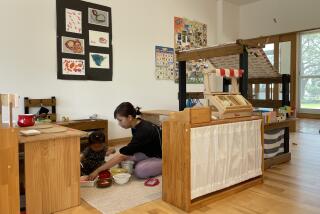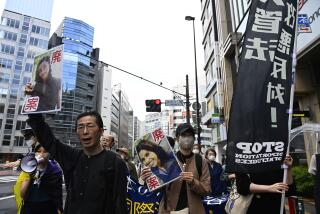Japan’s Ailing Economy Prompts Effort to Streamline Health Care System
TOKYO — The Japanese medical miracle has been good to Hiroko Iguchi.
Suffering from a rare skin disease, Iguchi was treated last year in a private hospital room, nearly all of it covered by insurance. Just to be safe, her doctors kept her there--for four months.
The care and relaxation paid off. After a while she felt so good she sneaked out of the hospital once a week to teach a college course.
“This is a society that’s been kind to sick people,” Iguchi said in her 16th-floor room at Tokyo Medical and Dental University Hospital, shortly before she was sent home late in the year. “Japan is rich, so it can afford it. But we’ll have financial problems in the future.”
That future is already here.
Health costs are soaring as the population ages. Insurance funds are in debt and sinking deeper. The system is bleeding from duplicated medical tests, overprescribed drugs and lengthy hospital stays.
Fears of a meltdown are pushing the government to charge patients more for health care, create a separately financed system for the elderly and overhaul the way the government sets prices for services and drugs.
“All the systems are in the red--that’s the biggest problem,” said Tomohiro Onishi of the Health Insurance Bureau of the Health and Welfare Ministry.
The troubles are a blow to the Japanese way of health, which has been credited with helping turn a sickly population ravaged by World War II into the world’s longest-living nation.
The key to that success has been universal coverage. A complex web of public and private insurance programs guarantees care for virtually all 126 million people.
And Japan provides that care more cheaply than many industrial nations. The Organization of Economic Cooperation and Development says Japan’s spending on health care was 7.2% of its gross national product in 1995. That compared to 14.2% for the United States and 10.4% for Germany. Britain was a bit lower, at 6.9%.
A government-linked panel sets prices for medical services. Most people pay premiums for their health insurance and must make co-payments for doctor visits. Patients go anywhere they want for treatment, and doctors’ orders are almost never challenged by insurance carriers.
The results have been impressive. Life expectancy has rocketed from 54 years for women and 52 years for men in 1947 to 84 years for women and 77 years for men now. The infant mortality is among the lowest in the world.
But the system, put together in the late 1950s for a country struggling to match Western standards, is running aground in today’s affluent, health-conscious Japan.
“The medical insurance system will collapse in the early part of the 21st century if drastic changes are not made,” the national newspaper Yomiuri warned in an editorial.
A major factor hobbling the system is a sign of its success: long life spans. Japan will have the world’s oldest population within a few decades--a big worry for health planners who say it costs five times as much to treat a patient over 70 as it does to treat a much younger one.
The trend is already taking a toll. Total medical spending has soared 400% since 1975, and the share taken by the elderly has nearly tripled, from 13% to 35%.
The climb in costs comes as Japan’s deepest recession in years is stifling incomes, meaning insurance fund contributions taken as a percentage of paychecks are not keeping pace. And declining birth rates mean there will be fewer workers in the future to pay for coverage.
But the problem is more than just an aging population. Quirks in the system have led to spiraling inefficiencies.
One example is hospital stays. Japan has few nursing homes, and most home-care services are not covered by insurance. So the elderly and chronically ill end up at more expensive hospitals--for months or even years. The result, the OECD says, is Japan leads the world in average hospital stays--45.5 days in 1995. The Netherlands was a distant second at 32.8 days. The United States averaged 8 days.
“The hospital has become like a welfare center,” said Masahira Anesaki, a sociologist at Nihon University School of Medicine and coauthor of “Health Care in Japan.”
In Iguchi’s case, it’s not clear whether she should have been discharged sooner. Her disease--pemphigus--is serious and long-term, and her weakened immune system means she is susceptible to other sicknesses.
But thanks to the discretion the medical profession has under the system, Iguchi’s doctor was free to consider nonmedical factors in deciding whether to send her home.
For example, Iguchi--a bilingual secretarial teacher in her 60s--had no one at home to care for her, so her doctor figured she was better off living at the hospital rather than going home and tiring herself.
“That’s why he’s been prolonging my stay,” said Iguchi, whose hospitalization originally was to have run 40 days but stretched far beyond that.
For all the babying Japanese patients get in terms of hospital rest, they also have plenty of complaints.
Doctors facing fixed prices cram their schedules with customers--in some cases more than 100 a day--meaning three-hour waits for three-minute consultations.
The system has also led to abuses. Doctors are accused of ordering unnecessary tests to make money, and the insurance system allows doctors and hospitals to make tidy profits on drugs by buying at discount and getting reimbursed at inflated prices.
The result, experts generally agree, is that Japan has one of the most heavily medicated populations in the world. The Health Ministry says Japanese doctors wrote 265.3 million prescriptions in 1995--an average of more than two for every inhabitant.
The government has been tinkering with the system for years. In 1997, co-payments for most people were increased from 10% of their doctor bills to 20%. Bureaucrats are also considering making the elderly pay a percentage of their health costs rather than a nominal fee to encourage “price consciousness.”
Much more fundamental changes are on the table.
One aim of the proposed reforms will be to force doctors to be more efficient by removing incentives to order unneeded tests and treatments. Regulators also want to set reimbursement levels for drugs more in line with market prices.
The government is also trying to set up a separate insurance system for the aged and provide coverage for cheaper alternatives to hospitals, such as at-home treatments. And hospitals--now falling dangerously into the red--will be encouraged to specialize rather than have all hospitals equipped to provide all services.
Still, bureaucrats acknowledge they are years away from fully streamlining the system. In the meantime, the Japanese are enjoying the cozier excesses--and putting up with inconveniences.
More to Read
Sign up for Essential California
The most important California stories and recommendations in your inbox every morning.
You may occasionally receive promotional content from the Los Angeles Times.










